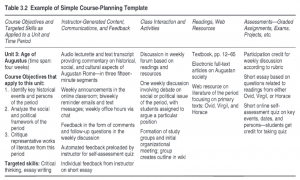A collection of resources relating to online pedagogy, course design, interaction and student engagement, and online course administration.
Online Teaching Strategies
Principles for Student-Centered and Asynchronous Online Teaching
Instructor Role, Communication, and Facilitation
Interaction and Student Engagement
Online Course Design
Course Design Considerations
- Backward Design (MIT Teaching + Learning Lab)
- Course map for aligning course and lesson objectives with assessments, learning activities, and interaction. See Example of Course mapping from Susan Ko, & Steve Rossen. (2017). Teaching Online : A Practical Guide: Vol. Fourth edition. Routledge. p. 57. Click to download PDF.

- Calculating Time on Task in Online Courses (Rochester Institute of Technology)
- Workload Estimator (Wake Forest University)
Inclusion, Digital Accessibility and Universal Design
- Inclusive Teaching and Course Design (EDUCAUSE)
- Digital Accessibility
- Cultural Diversity
- Universal Design
As a UM instructor you are encouraged to be proactive when it comes to making course materials accessible. It is best to design your course with accessibility in mind rather than fixing your course to comply with accessibility requirements afterwards. Universal Design for Instruction (UDI) and Universal Design for Learning (UDL) are two well-known proactive approaches to accessibility. You will find more resources on UDL on cast.org. For more information on digital accessibility at UM, please visit Digital Accessibility Solutions.
Copyright and Fair Use
- Copyright on Campus Video (Copyright Clearance Center)
- Quick Guides to Fair Use (University of Texas Libraries)
Resources from the J.D. Williams Library
Technology and Multimedia in Online Teaching
- Choosing Technology in Teaching (Video – University of New South Wales)
Consider learning objectives and purpose of use before technology, where/how students get tech support, and the benefit of starting simple. - Basic Design Principles for Digital Media Content
Watch our 5-minute video on Basic Design Principles for Digital Content that can be applied to your online content. - Creating and Using Multimedia Content
It is best to select or create multimedia content that is designed to support the learning process with clear intention and purpose. Refer to Mayer’s Principles of Multimedia Learning when creating your own materials to reduce cognitive load. Please remember to provide alternative means for visual and auditory information in a form of alternative text for images and captions or transcripts for audio and video content. - Design Presence is a combination of production, accessibility and aesthetic principles that help ensure a quality product (video) that supports a positive learner experience. “Design presence is vital in online learning. When the course interface – layout, navigation, interactions (Peters, 2011) – and materials, images, video, print (Schaffhauser, 2015) – are designed with production, aesthetic, and accessibility principles in mind, the learning experience is greatly enhanced.” (Humanize Online Teaching and Learning eBook, Chapter 8)
Templates and Checklists
Online Student Resources
- Online Student Resources
The link can be added to your Blackboard course menu as a web link.
Course Administration
Policies, Procedures & Guidelines to Follow
Checklist for common and recommended elements on a UM online course syllabus
Checklist for tips and suggested standard practices for UM online course design